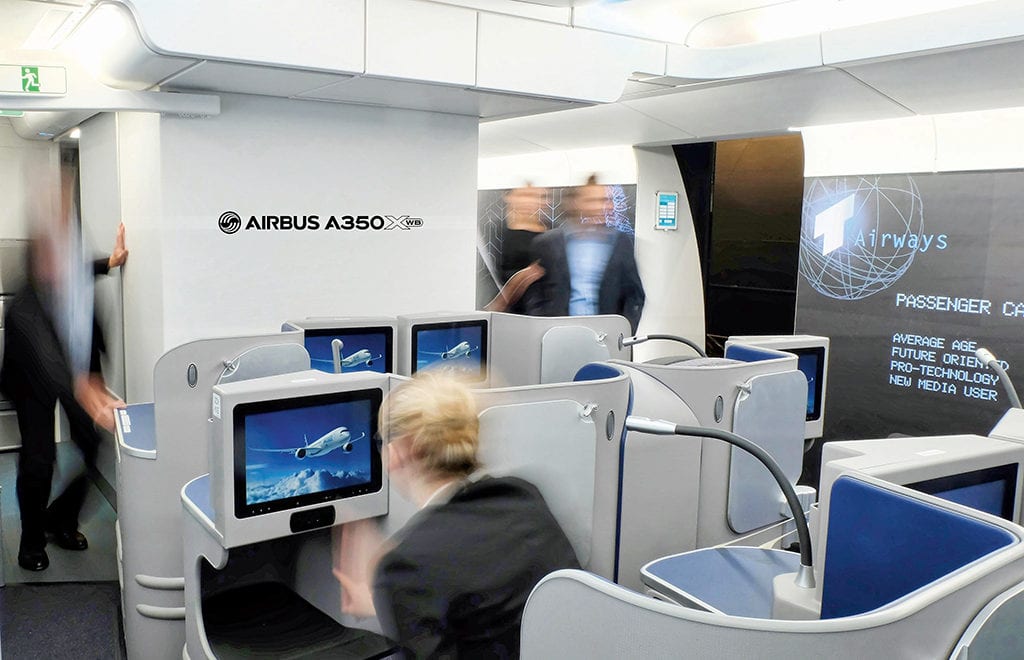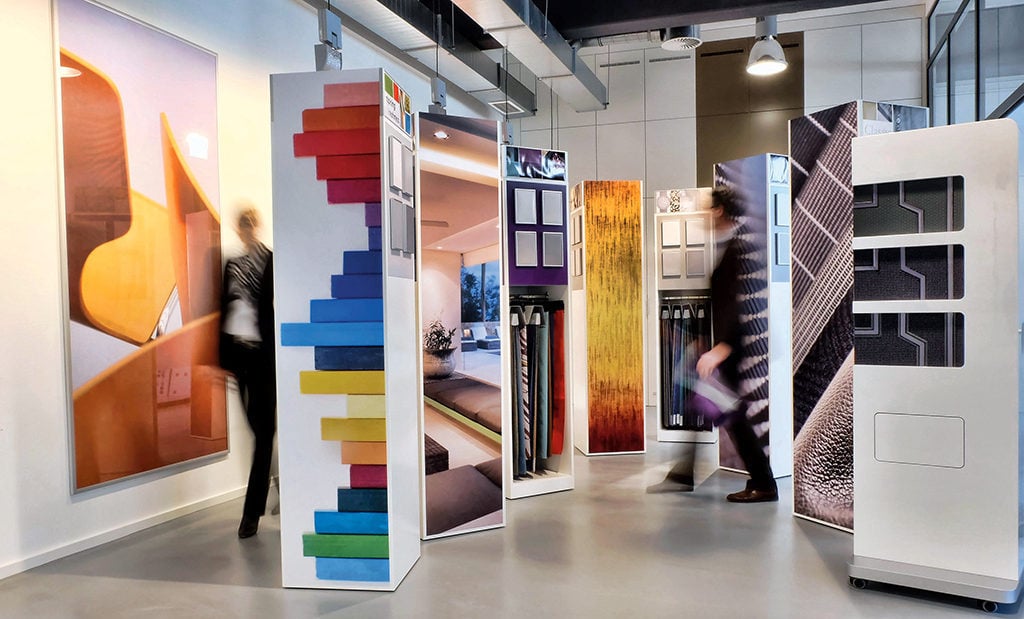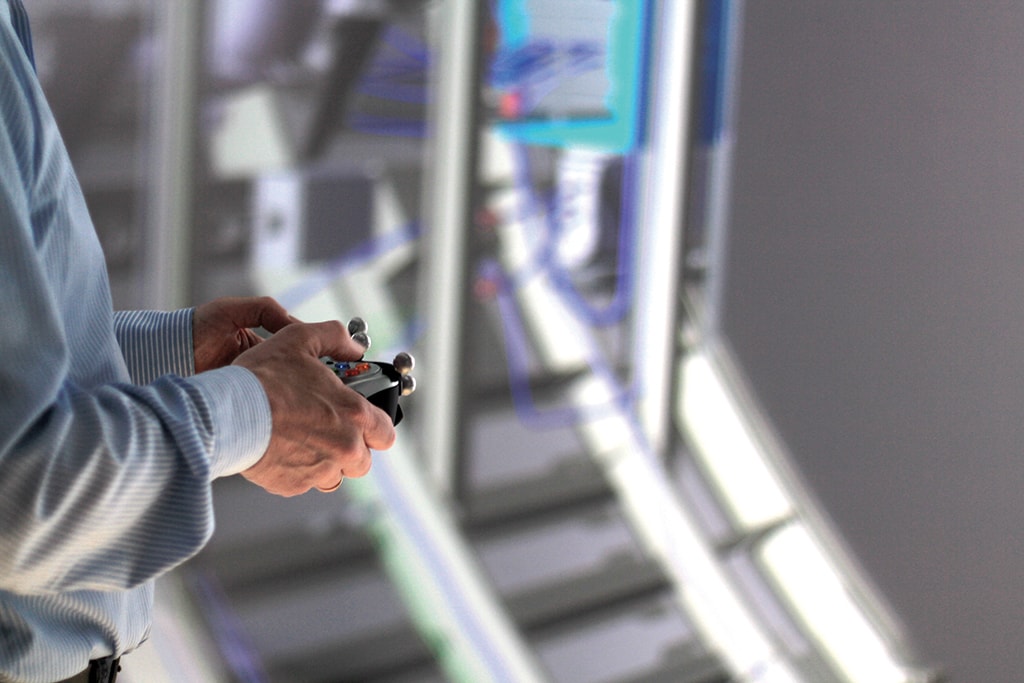Find Your Interior: Inside Airbus’ Customer Definition Centre
Share

APEX Insight: An A350 XWB cabin is a vessel for the onboard experience. There are thousands of options. Airbus’ Customer Definition Centre is where airlines are guided to find the right one for them.
Looking down the seemingly never-ending hall, most visitors are in awe when they enter the Inspire Room, the centerpiece of Airbus‘ A350 XWB Customer Definition Centre (CDC). For effect, it’s almost pitch-black inside. The only light emanates from high-set screens that run the length of the room, looping satellite footage of the Earth at night. Light beams bloom from London, Beijing and Dubai, representing departing flights from the world’s megacities. They bounce from screen to screen in rhythm with sparse, ethereal music. To the visitor, it feels as if you’re floating in outer space, reflecting on the state of air travel and the potential it holds.
“If you just put seats in here without any story behind them, that would be boring.” €” Ingo Wuggetzer, Airbus
A row of rooms lines each side of the hall, each concealing a unique concept of what a cabin interior could look like. Inside fuselage number one is T Airways, a cabin with subdued colors that might cater to business-attired professionals, whose in-flight agendas involve Wi-Fi and in-seat power. Fuselage number two holds Fun Air, an interior with rainbow-hued seats that might cater to vacationers, who order mai tais en route to their tropical destinations. “We create a theme of what the virtual airline is about and then we apply it in the fabrics, in the design, in the seats to create a real specific atmosphere that inspires customers,” says Ingo Wuggetzer, vice-president, Cabin Marketing, Airbus. “If you just put seats in here without any story behind them, that would be boring.”
A Personal Greeting
The CDC is where airlines go to outfit their A350 cabin interiors. Guests are invited to stay at on-site apartments while they spend their days roaming the many rooms in the building, exploring, learning and picking the finishings to personalize their aircraft. Representatives from Qatar Airways, Singapore Airlines and Finnair may have been among the site’s first visitors. Subtle industrial design details, such as a decorative hardwood circle on the floor in the exact diameter of an A350 fuselage, enhance the experience. “The building itself is a real tool,” says Eric Ezell, head of the CDC. “The architecture is defined by the A350 XWB definition process.”

Airbus sets the tone for the experience by placing the country flag of every incoming airline at the welcome desk. Lounges, prayer rooms and other amenities also help to make guests feel at home during their stay. Even the decorative LED wall that displays more than 16 million colors, showcasing the A350’s sophisticated cabin lighting system, is set to reflect the airline’s brand color.
“When customers come to the CDC … it’s not where things start,” Ezell says. “It’s basically where things come together.”

Located within the Hamburg Aviation complex, the site is in close proximity to aerospace partners, which helps to accelerate any processes that involve suppliers. “The customer only has to travel once to find all the customization elements and tools under one roof, including the experts of Airbus and risk-sharing partners to answer all their questions,” Ezell explains.
Gone are the Excel charts, the slideshows and the endless scheduling of meetings that used to overwhelm the definition process. Inside the CDC, decisions are fast-forwarded through highly intelligent software, virtual reality, 3-D walkthroughs and physical mock-ups that enable customers to envision many cabin interiors before choosing the right one. Take, for example, the touchscreen kiosk that scrolls through a multitude of materials and color combinations for a lavatory countertop in just a few minutes. “Normally, it would have taken months just to make a decision on some specific topics,” says Wuggetzer. Now, the entire process takes only about 12 months. “If there is a certain solution you have in mind, but are not sure about, we can build it like Lego pieces, do it virtually or do it in real size, one-to-one ratio to find the best solution fast.”
“If there is a certain solution you have in mind … we can build it like Lego pieces, do it virtually or do it in real size, one-to-one ratio to find the best solution fast.” €” Ingo Wuggetzer, Airbus
Much like a shopping mall, separate rooms and areas focus on specific design elements for the A350 XWB. In the Design Studio, customers can get a feel for the textures and textiles of different trim and finish themes, from Exotic Fusion to Modern Simplicity. Inside the Play Room, the latest in-flight entertainment options from Panasonic Avionics, Thales and Zodiac are on full display. “The purpose is to help airlines find their perfect cabin interior, down to whether or not they need a couple of inches more or less,” says Wuggetzer.

Artificial Natural Environment
Testing things in their physical space, simulating the cabin environment as accurately as possible, is imperative. Jet engine noise, for example, dampens unpleasant sounds. During one visit, a customer remarked that the mechanical screeching of a trash compactor seemed exceptionally loud. Airbus employees realized that on an airplane, the hum of the jet engine muffles the sound – so they added a feature that simulates the aural in-flight atmosphere to account for this. Now, when Wuggetzer demonstrates the trash compactor, he pushes a button that starts a jet engine murmur, reducing the compactor sound with white noise.
Cabin lighting is also a factor when imitating the onboard experience. An airline may request a complete dinner setup with food and tableware to see how various colors might affect passengers’ appetites. Even if a fish fillet is grilled to perfection, placed under green light, it can be off-putting. Amber is the best hue for in-flight mealtime, much like the candlelit ambience of a fine restaurant.
“You [can] test, feel and define everything in relation to each other.” – Eric Ezell, Airbus
Even picking out a galley kitchen can involve multiple trials. An airline may bring several trays of the same meal and conduct blind taste tests to determine which oven masters the art of heating broccoli, chicken penne or coffee to just the right temperature. “Everything is possible,” Ezell says, referring to the CDC’s various labs. “It’s a working environment that allows you to test, feel and define everything in relation to each other.”

Depth Perception
Once parts of the cabin have been defined, airlines can see their A350s come together through the magic of virtual reality. This happens in the A350 XWB Cabin Concept Centre, located a stone’s throw from Airbus’ CDC, which is also in the Hamburg Aviation complex. By projecting a cabin interior mock-up on three sides of a rectangular room, plus the ceiling and the floor, Airbus customers can get a sense of the space, can physically walk through transitions between cabin classes or see the difference between a nine- and 10-abreast configuration, for example. “Virtual reality really allows us to dive into the individual cabin layout,” Ezell says. “Here we can fully reflect the customer’s selection.”
All the materials and options that were selected during the definition process, including countertops, fabric and in-flight entertainment hardware, can be realized through virtual reality, down to the logo on the headrest cover. But defining a cabin doesn’t end with a three-dimensional digital rendering. “With light and trim and finishings on screens, you always have to keep in mind that projections can give a slightly different color character. In the end, you want to see the real thing, the real material in your hands to validate it,” Ezell says. “Some questions cannot even be validated on the screen, because it has to do with human interface with the machine, with accessibility of cabin situations, maneuverability of the trolley or the luggage,” Wuggetzer adds.
One of the final stages of the definition process is the Configure Room, where the A350 cabin is mocked up in one-to-one ratio. “It’s like a Lego room,” Wuggetzer says. In here, everything is white, stripped of all trims and finishings; it’s all about shape, size and fit. Colored markings along a guided track on the floor indicate setups for various seat pitches and configurations, letting customers test their seats in their chosen layout. When everything is in place, they get a tangible feel for how tall they stand next to a monument, whether it’s too difficult to roll a loaded trolley around a certain corner, or whether a baby bassinet prevents passengers from moving easily in and out of their seats.
It’s a cathartic moment for everyone. “It works so perfectly,” Wuggetzer says about the room. “We have seen so many happy people in here … We did not expect this to be a highlight of all the tours.”

Turning the Inside Out
For the design of the A350 XWB, Airbus drew some of its inspiration from a phenomenon born in the last decade – social media – where passengers most like to rant about airlines. The goal was to better understand not just their customers (airlines), but their customers’ customers (passengers), allowing the “personal” to influence the thinking behind cabin design. Launched in 2014, the A350 has a quieter cabin, expanded 18-inch-wide seats, seatback screens up to 12 inches wide, larger overhead bins and larger windows that let in more natural light. Collectively, the features make up the portfolio of Airspace, the new cabin product that has opened the possibility for greater personalization in the A330neo, and eventually other cabins, too.
In the age of personalization, it’s no coincidence that Boeing opened its own 787 Dreamliner Gallery in 2007 in Everett, Washington, to help its customers brand their cabins. The trend affects all industries. Steve Jobs made it literal by putting the “i” in iPod, iPhone and iPad. For airlines, it’s big data that has allowed them to identify passengers beyond their seat number, such as knowing a passenger’s frequent flyer status or if that person might be celebrating a birthday in the skies. But how do passengers discern one onboard experience from the next when there are so many airlines to choose from? It’s showing what’s on the inside that counts.
This story was originally published as “Find Your Interior” in the October/November issue of APEX Experience magazine.


